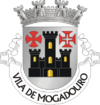Mogadouro
| Mogadouro | |||
|---|---|---|---|
| Municipality | |||
|
|||
 |
|||
| Coordinates: 41°20′25″N 6°42′58″W / 41.34028°N 6.71611°WCoordinates: 41°20′25″N 6°42′58″W / 41.34028°N 6.71611°W | |||
| Country |
|
||
| Region | Norte | ||
| Subregion | Alto Trás-os-Montes | ||
| Intermunic. comm. | Terras de Trás-os-Montes | ||
| District | Bragança | ||
| Parishes | 21 | ||
| Government | |||
| • President | António G. S. Moraes Machado (PPD-PSD) | ||
| Area | |||
| • Total | 760.65 km2 (293.69 sq mi) | ||
| Elevation | 790 m (2,590 ft) | ||
| Highest elevation | 996 m (3,268 ft) | ||
| Population (2011) | |||
| • Total | 9,542 | ||
| • Density | 13/km2 (32/sq mi) | ||
| Time zone | WET/WEST (UTC+0/+1) | ||
| Postal code | 5200 | ||
| Area code | 279 | ||
| Patron | São Mamede | ||
| Website | http://www.mogadouro.pt/ | ||
Mogadouro (Portuguese: [muɣɐˈðowɾu], Mirandese: [muɣɐˈðawɾu]) is a municipality in Portugal. The population in 2011 was 9,542, in an area of 760.65 km².
The history of Mogadouro is evident in the number of castros that dot the landscape of region from the neolithic period. In particular are the castros of Oleiros in Bemposta, Vilarinho, São Martinho do Peso, Figueirinha de Travanca, Bruçó and the more recently excavated castro in Vilariça, in the Serra da Castanheira.
The Celts passed through this region, leaving behind its art and religion, the so-called Cultura aos Berrões. One of these Celtic tribes, the Zoelae, were responsible for settling many of the lands along the Douro, Sabor and Angueira Rivers.
During the Roman period, the region is referred to in art, religion and socio-economic reports, indicating its regional importance. The Ara Romana to Deus Jupiter Depulsori (which still survives to this day in Saldanha), is one of these remnants of this period (it was constructed during the reign of Septimius Severus in the 3rd century BC). Throughout the municipality that are have been discovered many funerary stones and artefacts that attest the Romanization of these lands.
Vestiges of the Visigothic era are rare, but include a paleo-Christian inscription that was discovered in São Martinho do Peso (now in the Abade de Baçal Museum in Bragança.
Moorish influence in this region is limited to local handicrafts made from flax and wool, that includes the hand embroidery, quilts, rugs and towels. During the Reconquista era, it is known that Alfonso III of León effected many construction projects during his reign, that were more strategic then political: organizing a military line along the Douro with castles (to protect the holdings of the León while inducing incursions into Moorish lands, populating conquered territory and taking advantage of natural geography to defend his territory. After fortifying Zamora, around 893, he ordered the construction of castles along the line, repopulating them as he progressed. Toro and Simancas developed consequently from this policy. It is likely that the area of Mogadouro was settled as a strategic point along the line, resulting in the construction of the first fort. The regions name evolved from this settlement: Mógo means a implanted marker, considered a symbolic delineation of the separation or division of a territory, a term imported from common language at the time. The mógo do Douro (mark on the Douro), or Mogadouro, developed from this locational designation.
...
Wikipedia


